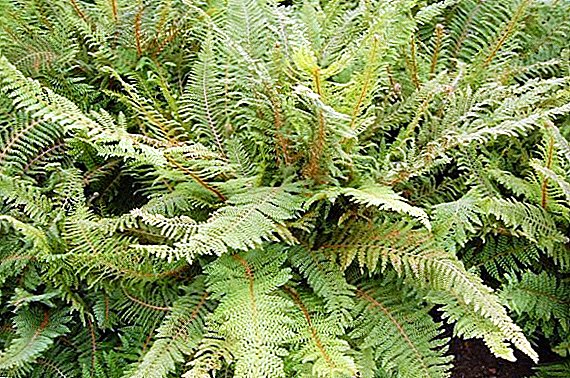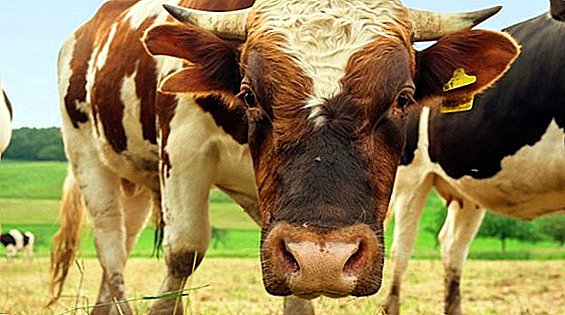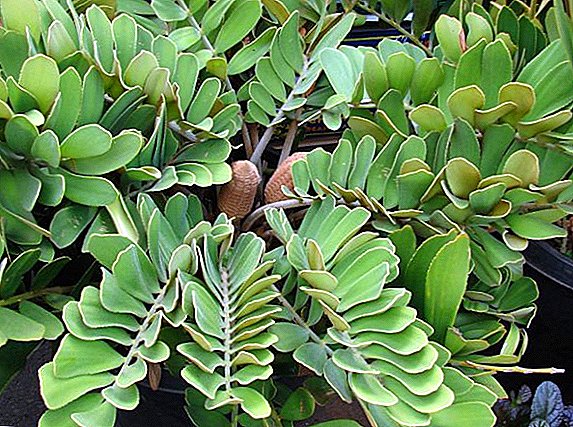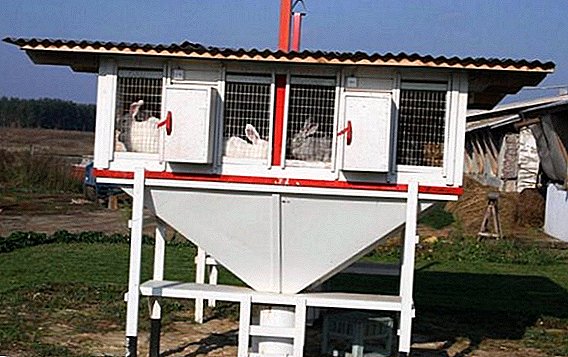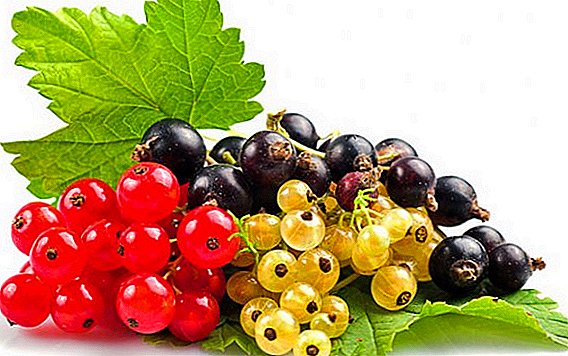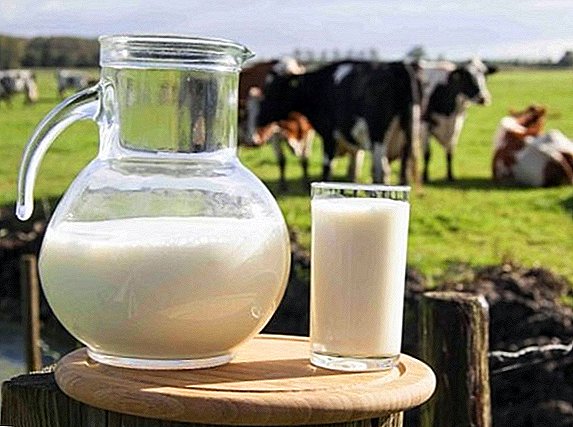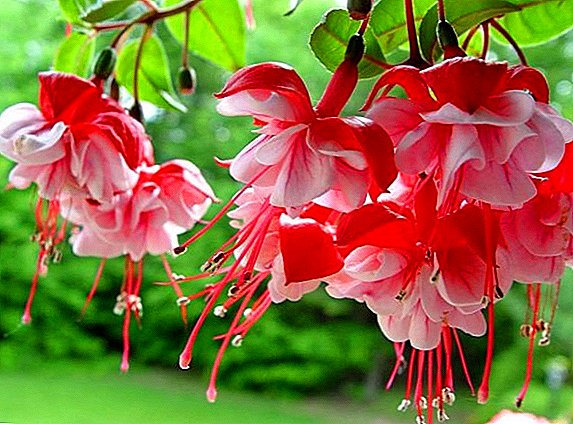 Amputel fuchsia with its long stems hanging from hanging pots became popular not so long ago and immediately won the hearts of all flower lovers who appreciated its decorative charms and characteristic properties. Several flowerpots with an ampel variety of this plant are able to skillfully decorate a porch, a balcony, a terrace, a veranda or a sufficiently large wall of a house.
Amputel fuchsia with its long stems hanging from hanging pots became popular not so long ago and immediately won the hearts of all flower lovers who appreciated its decorative charms and characteristic properties. Several flowerpots with an ampel variety of this plant are able to skillfully decorate a porch, a balcony, a terrace, a veranda or a sufficiently large wall of a house.
Description
Fuchsia (Fuchsia) - perennial plant of the family Cyprus. Due to the numerous variety of ornamental varieties with unusual bright flowers, this tenacious evergreen flower has deservedly taken pride of place among ornamental plants.
Did you know? About fuchsia has been known for more than three hundred years. The name was given by Charles Plumier, a French scientist from France, who in 1696 saw the unknown plant near the current capital of the Dominican Republic, Santo Domingo, and named it after the German scientist and physician Leonart von Fuchs.There are many hybrid forms of fuchsia: with straight stems, with pyramidal, sprawling, hanging, climbing, in the form of a bush or tree. Of particular interest in modern design is fuchsia ampelnaya with thin stems, forming a crown in the form of a cascade. The length of bright green oval-shaped leaves with sharp tips is about 5 cm.
 The variety of colors is striking in its variety: white, red, pink, blue, blue, purple, yellow. The flowers themselves have an unusual shape because of protruding stamens from under the lush petal skirt that comes out of the tubular corolla.
The variety of colors is striking in its variety: white, red, pink, blue, blue, purple, yellow. The flowers themselves have an unusual shape because of protruding stamens from under the lush petal skirt that comes out of the tubular corolla.In the modern world, fuchsia used to be known only as a houseplant that blooms all year round. But over time, she increasingly began to appear in the warm season on the street, decorating the exterior of houses and flower beds of gardens. About ten thousand species of this plant are known in the world.
With proper care, it is able to bloom from spring to the very autumn, the peak of its bloom is in April and October. The plant is so unpretentious that it brings pleasure to flower growers.
The house and the summer balcony can decorate such climbing plants: a scandus, philodendron, hoya, stephanotis, diploadiya, tunbergia, indoor ivy.
Varieties for cultivation in pots
Fuchsia from South America and New Zealand. It was from there brought many varieties of this plant. Ampelnaya fuchsia brought recently. Known terry, semi-double and simple varieties, some of which we briefly consider.
- "Holly's beauty"- a variety of flower in white and pink tones, with terry petals.

- "Prince of Peace"- a plant that dissolves ordinary flowers with white sepals and red skirt.

- "Blue angel"- plant variety, famous for the chic combination of lilac and violet shades of flowering, faceted by white sepals.

- "Imperial crown"- a plant with elongated scarlet flowers collected in clusters.

- "Bicentennial"- ampelous variety with oblong, rather large double flowers in the form of buds with sepals in bright colors, which eventually turn into orange.

Did you know? The color "fuchsia" is named after the eponymous plant. Its name for the color of its aqueous solution, similar to the color of fuchsia, received and fuchsin.
- "Marinka"- ampelous fuchsia, flowers of which are common and monochromatic, but look great because of the extraordinary brightness and abundance.
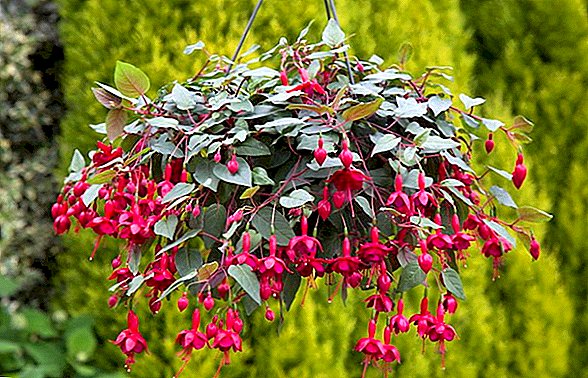
- "Santa clara"- variety with double large flowers consisting of cherry skirt and white sepals.
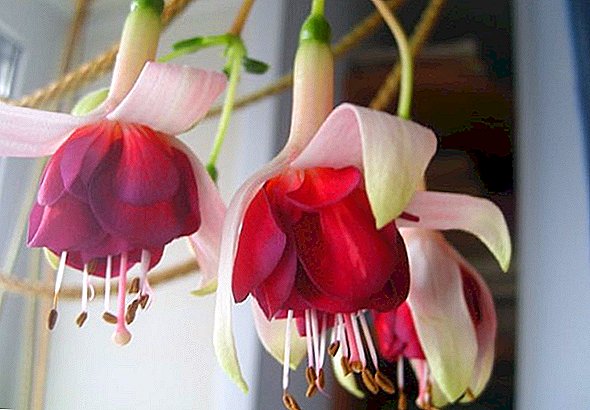
- "Niedersachsen"- a very spectacular fuchsia with large double flowers, in which the sepals are red with a white edging. The popular name of this fuchsia is" ballerina ".
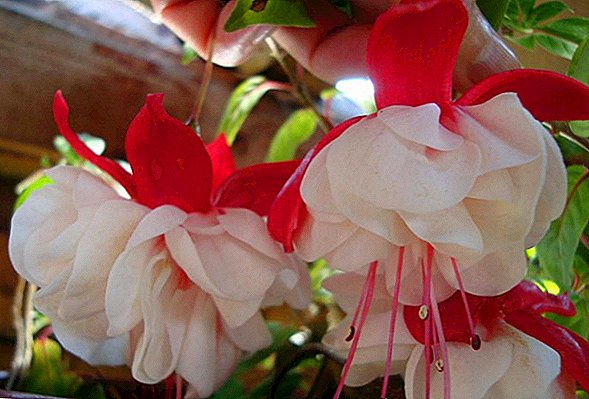
- "Peachy"- ampelous fuchsia with large oblong buds. The flowers of this plant are terry with white sepals with a delicate pink edging.

The following types and varieties of fuchsia can also be placed in pots:
- "Annabel"- the variety is in ampel form, but it can also be grown in the form of a bush; it has rather large, white flowers with a slight pink tinge.

- Three leaf leaf fuchsia - Bush up to 60 cm, growing horizontally. This variety is conveniently grown in pots. It has ovoid green leaves about 8 cm long, with a front side with a red tinge, the bottom with a brown one. On the leaves there is a little fluff. Flowers of a three-leafed fuchsia in the form of a bell of red color with an orange shade are collected on several flowers in inflorescence. Great for decorative use with the creation of whole flower arrangements.
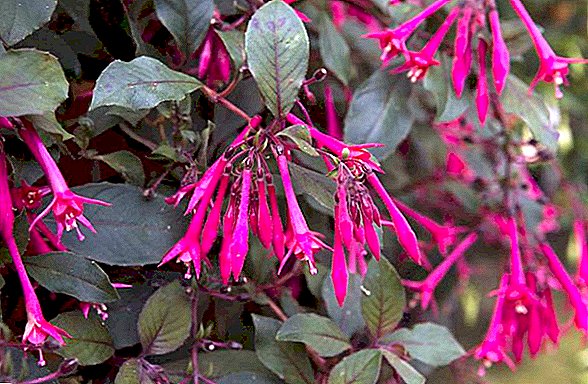
- Fuchsia lying - A creeping plant with upward-looking flowers in pink or orange tones. Suitable for flowerpots and flower arrangements. It blooms in the warm period of single flowers.
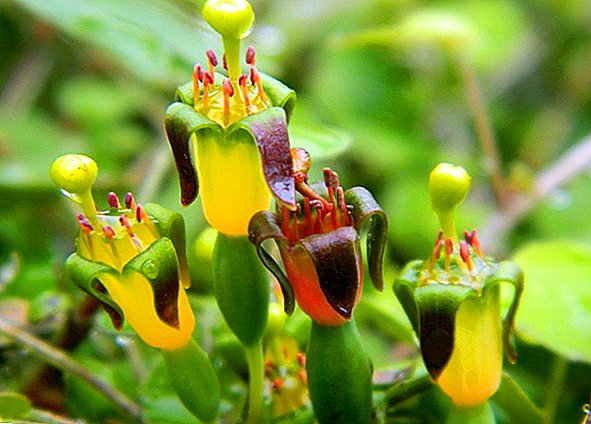
- Fuchsia bright red - a luxurious plant with scarlet flowers on thin stems. The leaves are oval-shaped on small stalks.
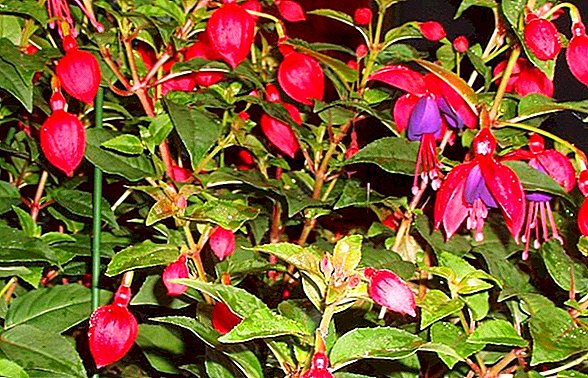
- "Archie owen"- semi-fluffy variety with impressive pink flowers.

- "Bella rosella"- one of the few fuchsias with the largest double flowers in lilac and pink colors.
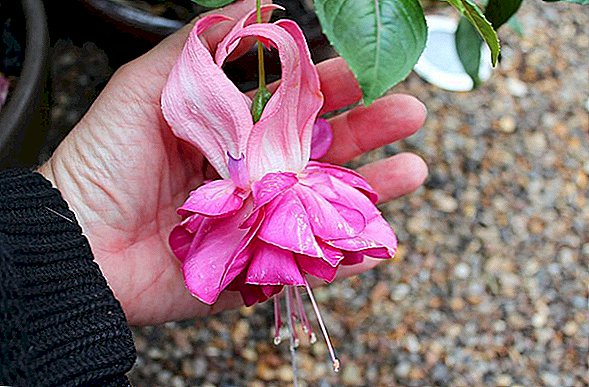
- "Blue mirage"- A plant that can be either in the ampel form, or in the form of a bush. It has amazing rich purple flowers with white sepals.

- "Blue veil"- a plant with beautiful petals in lilac color, bordered by white sepals with verdant tips. It can grow in plain form and in the form of a bush.
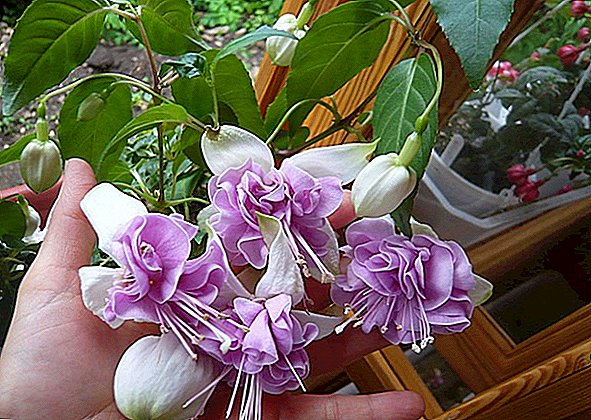
- "Cecile"- an unusually beautiful ampelous-bush plant with wavy lavender petals of dense flowers and pink sepals.
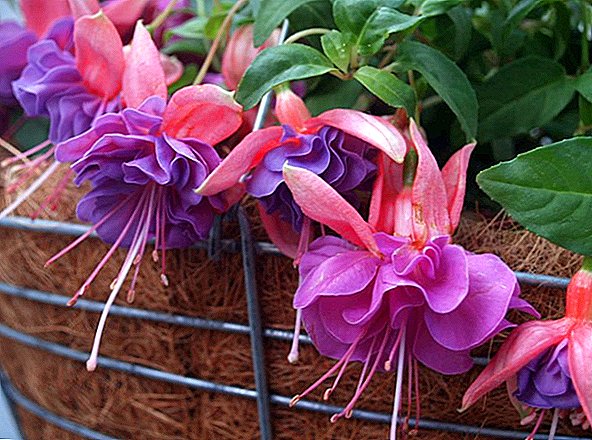
As a pendant plant, ampelous petunia, calibrahoa, surfinia, bacopa, begonia, verbena, dichondra, campanula, lobelia will look advantageous.
Fuchsia conditions
If ampelous fuchsia to create comfortable conditions for growing and to provide the right care in the home, then it can please others for more than one year.
Lighting and temperature
Ampute fuchsia varieties feel comfortable in partial shade or when illuminated with moderate brightness, do not approve of direct sunlight, do not tolerate drafts and cool air. Direct sunlight affects them depressingly: the plant will not die, but the flowers will become very small, the leaves will thin out considerably, and it will be almost impossible to return the former luxurious look. All these factors must be considered when placing them.
Fuchsia feels much better in a place where she receives sunbathing only in the morning, and from noon to dusk it is advisable to be in partial shade. It is most suitable for the eastern side, as well as the south-west. But it should be noted that with a long stay of this flower in a shady place, the number of flowers noticeably decreases. If he does not have enough light for a long time, then the plant will not bloom or may die. In this case, it must be rearranged to a lighter place, if there is no such possibility, then artificial lighting can help out.
If he does not have enough light for a long time, then the plant will not bloom or may die. In this case, it must be rearranged to a lighter place, if there is no such possibility, then artificial lighting can help out.
The optimum temperature for growing fuchsia should be approximately +22 ° С during the day and not lower than +15 at night. Very high, as well as low temperatures adversely affect the flowering process. The plant adapts to temperature conditions: when there is a lot of light and heat around, the flowering will not stop (spring, summer, autumn), if it gets cold, the buds no longer appear, the development of flowers slows down (at the end of the autumn period, in winter).
Important! Fuchsia does not like being disturbed once again, moving it from place to place, especially during periods of flowering - she will simply get rid of flowers.
Capacity size and substrate
All parts of fuchsia do not like high temperatures, including its rather tender roots. 
Important! In order to prevent overheating of the roots, it is recommended to grow fuchsia in ceramic containers in bright colors with thicker walls, and the top layer of soil can be graveled, preferably a light shade.In the usual pot the roots can easily overheat. If the plant will overwinter on the windowsill in the room, then under the container you need to make thermal insulation.
Fuchsia is not very demanding on the soil for cultivation, but it feels more comfortable in fertile, neutral to acidic soil with the possibility of easy access of air, and for this the land must be porous. There are several options for the combination of the components of the earth mixture, intended for the cultivation of this flower, it is also permissible to use the finished mixture for any plant. The substrate for fuchsia can consist of peat, humus, sod and leaf earth, sand, and expanded clay can be used for drainage. Also, the earth mixture is made from peat, sand, perlite and clay.
Planting and breeding
The process of planting amuleous fuchsia, reproduction and care for it have a number of features that must be adhered to. The reproduction of this plant is best carried out in early spring when using cuttings or planting seeds. The first method is much easier.
Important! Fuchsia in no case can not be planted in a container, much larger in size than is necessary for its root system. The dimensions of the pot increase in stages. At the initial stage of growing fuchsia, its diameter should not exceed 9 cm. Once the roots have grown all over the soil in the container, the plant can be transplanted into a slightly larger pot.
Seed method
At home, fuchsia is grown in the seed way is extremely rare, except to experiment. This process is rather complicated and has many nuances, but it cannot be said that it is ineffectual.
Seeds can be purchased at a specialty store. They can also be collected from a home plant, which is a very entertaining process. First, self-pollination must be avoided; for this purpose, it is necessary to tear off the anthers on the flower and place the desired pollen on the stamens.
After that, wrap the bud in gauze fabric and fix the thread, in this state it will stay less than a month, until the fruit appears. All this time, any movement of the flower is contraindicated. The finished fruit is removed, carefully cut and removed the seeds that need to be dried. 
Did you know? All parts of which fuchsia consists can be used as food. From its fruits cook delicious jams.Only after that the seeds are ready for sowing, which is best done in early spring. Fuchsia seeds are laid out on wooden boxes with a mixture of peat and coarse sand on the surface and lightly pressed with fingers. Planting seeds deep into the soil is not recommended: they may not ascend.
The boxes are covered in the form of a small greenhouse with sufficient illumination without hitting the direct rays of the sun, creating the necessary humidity and temperature within 18-22 ° C. Regularly once a day, the greenhouse must be opened for a few minutes to ventilate, and the condensate must be removed and watered with settled water at room temperature with a sprayer. If a responsible approach to this process, then a maximum of two weeks will sprout.
After the emergence of seedlings, the greenhouse can be left open each time for a longer time, so that the sprouts get accustomed to normal humidity and room temperature more quickly. After the young plants grow noticeably and become accustomed to the natural conditions, they are transplanted one by one into separate pots, before which the plants and fertile fertilized soil are well moistened. Potted plants with young flowers for the first time placed in a shaded place.  Further care of such plants consists in feeding every two weeks after planting, regular fertilization of the soil, placing the plant in high-quality diffused lighting, systematic watering, cutting in the period of active growth, annual transplanting.
Further care of such plants consists in feeding every two weeks after planting, regular fertilization of the soil, placing the plant in high-quality diffused lighting, systematic watering, cutting in the period of active growth, annual transplanting.
Vegetative reproduction
The best way to reproduce fuchsia is through cuttings that are easy to avoid problems: shoots take root perfectly. This method is more popular and much easier than seed. Its main advantage is a small waste of time with an excellent result. The best period of this breeding is also spring. Young shoots are ideal for cuttings, because the old stiffened ones are taken much longer and grow more slowly.
The length of each cutting is individual and depends largely on the fuchsia variety, it can vary from 8 to 20 cm. Before putting the sprout into the separated or filtered water, it is necessary to tear off the leaves so that no one comes into contact with the water, otherwise they will start to rot and mold , and this will adversely affect the condition of the cutting.
Large leaves on the shoot are also not needed: they take a lot of moisture, which is necessary for it to form the root. The glass with the sprout should be covered with polyethylene to maintain sufficiently high humidity. If done correctly, the roots on the shoot will be noticeable after a few days, but a couple more weeks it is necessary for the root to become full.
It is possible to transplant a young plant into the soil when the first roots appear, it is not necessary to wait for the formation of the entire root system, but still it is safer to wait for these few weeks.
Further care for young flowers occurs according to the same rules as for plants obtained with the help of seeds. There is another way of propagation using cuttings - when they are planted directly into the substrate, but at the same time you need to make a kind of greenhouse over them, the way out of which is a bit troublesome for gardeners and dangerous for the germinated plant: it can even die if you do something wrong or hurry.
How to propagate a fuchsia - it's up to everyone individually, the main thing is to learn all the simple rules, and it will surely take root and bloom.
Care features
Amputel fuchsia deservedly enjoys the love of flower growers not only for its attractive appearance, but also thanks to its unpretentious care in the garden, in flowerpots, in a flowerbed or in a pot on a window sill. After all, the growth of amfelia fuchsia can occur both in the shade in the garden and in open space, not protected from the sun, it does not make special demands on the nutritional value of the soil and frequent watering, and you can get as much pleasure from its beauty as no other plant.
Watering and spraying
Rational watering is of great importance when growing fuchsia. How often the plant needs watering, how much liquid it needs, is influenced by various factors: weather conditions, the type of flower, its location, development stage and even the size of the pot and the material from which it is made.
For irrigation it is recommended to use separated or melt water. It is necessary to water a flower in rather moderate quantities. During active development, the soil should be slightly wet. In the summer of ampelous fuchsia will not prevent spraying pretty cool water. Excess water remaining after irrigation, it is better to drain. From the end of autumn it is enough to water the plant no more than once every two weeks. With the arrival of frost, the plant can hardly be watered or it is rarely done.
Excess water remaining after irrigation, it is better to drain. From the end of autumn it is enough to water the plant no more than once every two weeks. With the arrival of frost, the plant can hardly be watered or it is rarely done.
Pruning
Fuchsia pruning must be done. It contributes to the rejuvenation of the plant and the formation of the crown, interferes with the process of exposing the stems. Pruning is carried out annually in the spring. Shoots are cut to one third of its length around the entire circumference of the flower in order to create symmetry of the plant.
Fertilizer
Fuchsia fertilizer is necessary for its better development. The fertilized plant is noticeable from afar: it blooms extraordinarily beautifully and flourishes. These plants usually begin to be fertilized as soon as the first flowers appear, and continue to do this while it actively blooms and develops. Top dressing is made approximately once a week by liquid complex fertilizers for plants in which it is necessary to control the level of nitrogen. In winter, the flower does not need fertilizers. 
Transfer
The transplantation process is also very necessary for its formation, because with the new soil it receives all the necessary trace elements and nutrients. Young plants are transplanted once a year, more adults are enough to transplant every three years.
The transfer method is optimal for transplanting fuchsia: it is gently rolled over, preserving the integrity of the old earth with the root system, and a fresh earthen mixture is added to the free space of the pot, preventing the formation of a void between the root system of the flower and the walls of the pot. After that, the plant must be watered and left to adapt. In no case can not forget about the drainage layer.
Possible diseases and pests
A healthy and properly groomed ampelous fuchsia pleases its owners with rich green leaves and gorgeous flowers. As soon as something in the process of leaving goes wrong, it is immediately displayed on the state of the plant: it can get sick or be attacked by pests. 
- Spots on the leaves can talk about high humidity. Если листья начинают желтеть и сохнуть, то это, скорее всего, признак полива выше нормы. Полив фуксии должен быть умеренным, особенно зимой.
- The spots that appeared in the lower part of the leaflets are a sign of an infectious disease. Leaves with such spots should be removed, and the plant should be sprayed with Bordeaux liquid.
- The lifeless and dull appearance of the leaves indicates a nutrient deficiency in the substrate. It is necessary to transplant and feed the plant.
- Whitefly can also enjoy fuchsia - a small midge of almost white color, which multiplies quickly, laying eggs on the lower part of the leaf, and removing it becomes a problem. If she is not noticed at the very beginning of appearance and does not start treatment with insecticides, then she will cover the whole flower. And the sticky fluid secreted by it becomes the cause of the fungal disease. Illumination and watering a flower, according to the rules, will help avoid the attack of the whitefly on the plant.
- If a spider's web appears on the underside of the leaflets, the plant is attacked by a spider mite. It is necessary to fight it with folk remedies, but if the attempt is unsuccessful, resort to the help of insecticides.
Plants should be regularly monitored, inspected them, adhere to the rules of care and in time take all measures to get rid of problems.
Amppelnaya fuchsia is a plant that is simply impossible not to fall in love, because it does not require a lot of care, but thanks for the comfortable content of the unimaginable beauty of its flowering almost all year round.






















